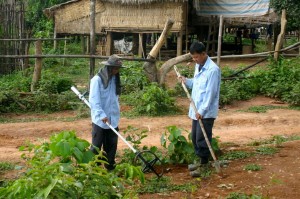Project Sekong 2013: Two Different Approaches To Clearing Unexploded Ordnance

Deminers doing area clearance use detectors to thoroughly inspect a parcel of land. They will excavate and inspect all metal objects that trigger a signal
There are, basically, two kinds of unexploded ordnance (UXO) clearance. The form that probably comes most readily to mind is “area clearance,” in which technicians sweep an area with metal detectors, searching for ordnance. From a distance the techs might well appear to be using equipment similar to that sold on the consumer market. In fact, our detectors are far more elaborate and cost upwards of $3,000 each. We need sophisticated equipment to ensure that no potentially lethal items are missed. Missing a single dangerous item the size of a ping-pong ball could result in someone losing their life.
One critical aspect of area clearance is the depth to which we search. It is not practical, nor economically feasible, for us to search every area to maximum depth. While most unexploded ordnance will be found near the surface, many items — such as large general-purpose bombs — may be four, five, six or more meters underground. How deep we search depends on the planned future use of the land. If we are searching future rice fields, we usually limit our search to the top 25 or 30 centimeters — plowing depth. If the land may be the site of irrigation ditches or toilet pits, we must search far deeper. We are capable of searching as deep as is necessary.
 The second kind of clearance is “rapid response.” In the case of response clearance, we don’t go looking for UXO, but respond to reports of ordnance (or even suspected ordnance) found by villagers in the course of their lives. Response clearance is exciting work, because every report must be handled as an emergency. We always assume lives are immediately at stake.
The second kind of clearance is “rapid response.” In the case of response clearance, we don’t go looking for UXO, but respond to reports of ordnance (or even suspected ordnance) found by villagers in the course of their lives. Response clearance is exciting work, because every report must be handled as an emergency. We always assume lives are immediately at stake.
Interestingly, in Laos more ordnance is destroyed each year by response teams than by teams doing area clearance. That may seem counter intuitive until one considers how few teams are actually conducting area clearance and how many villagers are exposed daily to the vast quantity of ordnance that remains scattered across the countryside.
Throughout Laos, millions of villagers work the land every day and frequently come in contact with unexploded ordnance. Response teams need to respond quickly to new discoveries, before villagers assume the risk of moving or destroying items themselves. Fifty percent of all accidents with ordnance in Laos involve people intentionally handling items.
